|
Hey everyone, it's Stacy and I'm thrilled to be writing this post. I appreciate the little pockets of "creative outlet" I can find in this whole new normal we're living in. Let me share a little about myself so you can catch my perspective. I'm a wife, a mom of 3 kids, we have a bunch of little animals at our house (7 chicks, a dog, and a bunny! - and yes, you can come to our urban petting zoo when this is all over!) We are one of the families impacted by the astounding lay-off statistics which happened to account for 95% of our family's income. We have 2 school aged children and are navigating distance learning for the long haul, our other child is in the medically vulnerable population, and we're just doing our best to live life and be happy and make this whole crazy thing work. We're happy, worried, soaking in all the family time and utterly exhausted by the end of each day all at once.On top of that, I'm also trying to make sure I am taking care of myself by doing things that fuel my soul and make my body happy - one of those being Bikram Yoga. I am no expert... at, well, any of this. I am not a long-seasoned yogi. I am certainly no expert at managing a life and a household during a global pandemic. I mean, is anyone? But I do want to offer a couple ideas that have been extremely helpful in finding peace, balance, and time to practice yoga. First, let’s chat about peace.It almost seems like a taboo topic right now. Peace? In the middle of all this?? Isn’t that completely neglecting the reality of the world right now which feels pretty full of unrest? Are you actually being a toxic-positive person?? Yikes. No, definitely not. I don’t know about you - but I cannot just sit and soak in sadness and despair. It’s already here, I don’t have to do anything else to help it exist. Don’t get me wrong, I could get completely caught up in the endless amount of news floating around, but my peace would suffer. Right now I must keep my peace for my own sake and also for my family’s sake, since we are cooped up together 24/7. So how do you do this when you’re busy and being pulled in a thousand directions from your kids, spouse, life, etc. You decide.You must decide you are deserving and worth it and peace is as essential as water and air to live and thrive and you must must must make it happen. Finding peace looks different for every single one of us. It could mean dedicated quiet time, exercise, laughing, reading, napping, fresh air, praying, meditating, journaling, painting, creating, the list is endless. Whatever it looks like for you, do it. Do it as often as you can. I'd love to say I carve out pockets of peace every single day, but I don't... I wish!! But I do the majority of the time. And in my life, majority rules. After peace, I try to create a little balance in our day. Ah, the great "balancing act." I can’t possibly fit in everything I want and need to do every single day in our busy household, but I can find a sense of balance that makes me feel like I’ve got a (small) sense of control to what’s going on around here. Even though we are not going out as much, I notice feeling just as busy (if not more) at home! Kid's school work, house projects, Zoom meetings, the endless amounts of cooking and cleaning, getting in some exercise, carving out time for yourself and/or your partner, and each kid, and walking the dog... did I mention cooking and cleaning yet? Don’t forget you need to rest! And and and… am I right? It’s a lot! And it’s totally ok to feel like it is, because hey: IT IS. I mean, there have been multiple days where I had planned all the things, and then just sat around, re-dried the same load of laundry 3 times and ate snacks all day. Well, I quickly learned that was not going to work for me, and just as quickly realized balance is possible. Thank goodness, too! Here’s what works for me, and if you’re struggling to “fit it all in,” maybe this can help you feel less overwhelmed with it all: 1. Make a list of "non-negotiables"These are things that are absolute musts for yourself and your family. Family dinner, time outside, breakfast together, quiet time… what are they in your life? This list doesn’t have to be long, but I encourage you to evaluate all the things you are busy doing, and pull out those key things that keep your household functioning and moving forward. 2. Set a scheduleDon’t you feel better when you know what is coming next? This schedule doesn’t have to be strict or even down to the minute, but more so a guideline to what and how you will move through your day. A rhythm. The rest, listen closely: IS OPTIONAL. I know… I know! Give yourself, your family, and your day the grace it needs and deserves to be fluid enough to feel good. It's called balance 3. Do yogaAhhhhh... yes, the yoga. My brain already feels a sense of calm coming over it just thinking about it. How do I fit this in? Like seriously, I can barely take a 10-minute shower without interruption let alone dedicate 90 whole minutes to myself, inside my house, with all these people and animals. Before, I could go to the studio, I could shut off all the things, the hot room was a sweet and sweaty escape, I could "hide" away and just... do something for myself. Yoga looks pretty much the opposite of that right now in every way, except that it is still yoga - and it's for me - practiced by me - and the benefits are all mine. Having to practice at home has uprooted all the "feel good" things I love about yoga and has forced me to a realization that yoga is so valuable to my life, even without all the frills of the studio environment. Is my space hot? No. It's a little hot with chaos some days. Do I have a mirror? Also, no, not really. Does my toddler mimicking me count? Can I get it humid enough? Not nearly. But sometimes, I have a couple kids or a dog breathing right in front of my face and it feels a little humid... (kidding. not kidding.) Do I get to focus and meditate completely? Ehh... not entirely. And by entirely, I mean not at all. Am I able to complete an entire 90 minutes, uninterrupted? Negative. I don't even always get a chance to complete 90 minutes at all. I have learned that in order for me to have a successful home practice, I had to reconstruct what the word "successful" means. I often practice in the middle of the living room floor, or when it's nice out, I throw a mat down outside. Always, I have a couple kids bopping in and out and lying down next to me, or on me, or trying to crawl through my legs, a dog rolling around on the floor thinking it's playtime, or kids taking their own sweet savasana on top of me while I'm in one too... The commotion is endless. But the yoga is timeless. I've learned to let go of my idealistic perfect yoga experience, and realize that yoga IS the experience. Some is better than none, and I've had to adjust my mindset from tolerating that, to celebrating that, and remarkably I can say that my body and mind are still reaping the benefits of a "not-so-perfect" yoga practice. My family and I are better for it, and I’m really glad I decided to just get over the fact that yoga is different now, and get to doing it for any amount of time, at any time of day. The truth is, some of us haven't been in a good habit of practicing yoga since the stay-home orders have been in place. That's ok... kind of. If it's truly just not for you, not important to you, and yoga has not been a positive impact in your life, then sure, it's ok to not be practicing But some of us need to check our yoga-egos (I know I did) at our own front door.We need to realize that the benefits of practicing at home, an imperfect practice in a less-than-ideal environment, win out by far over the consequences of not practicing at all.
And here's the good news: it's a practice. This is quite possibly the only time we will be forced to practice peace, balance, and yoga in a world that looks like this, in a home space that exists like this, and in a mindset that feels like this. I for one am optimistic for my future self - that I will have learned so much during this time in a way that I never would have before. I mean, can you even imagine how good my savasana will be when we get back into the hot room after all this practice with my kids jumping all over me? Ha! So here's to you, and me, and all of us. Making an attempt for joy in our life, through the practice (and grace!) of peace, balance, and yoga. See you at Home! Always, Stacy
0 Comments
This coronavirus epidemic has destroyed our sense of normalcy. It’s turned our worlds upside down, leaving us feeling scattered and out of sorts. Everything that was familiar and routine is gone. We’re finding ourselves having to make adjustments to our lives, to make room for this new (hopefully temporary, but real) normal. It can sound counterintuitive, but developing a daily routine can help us to feel a sense of control and help us to make room for our more-important-than-ever self-care. Routines create predictability and reduce our stress level.But what if reclaiming your previous self-care routine isn’t possible given these new circumstances? Or what if you never had much of a daily rhythm before, but feel desperate for the stability of one now? Where do you start? You start small. That’s where. Use the behavior change strategy of Kaizen or 1% improvement over time. “Kaizen” is a Japanese term that refers to small, continuous improvement.It’s about making 1% improvements every day. So, let’s say you’re someone who staying up past midnight every night lately. You want to go to bed earlier so you have energy for the next day. Instead of forcing yourself to go to bed at 10pm tonight, you go to bed five minutes earlier. Five minutes is your 1%. If you go to bed five minutes earlier everyday, it will take you at least 24 days to be in bed by 10pm. This is kaizen. At first, it feels like there is no improvement. (You might think: 11:55pm is barely earlier than midnight! I’m desperate for some change now!) It takes some time for each day of 1% change to accumulate. Once these small improvements do build up though, you’ll begin to see and feel the effects of your gradual shift. With gradual change and continuous improvements, our nervous systems slowly adjust to our new ways of being - allowing our new habits to stick. Which is really what we need. Better habits now to reduce our stress and better habits that last beyond this crisis, so we remain healthy in body and mind. Cate Stillman writes this in her book Body Thrive: “The problem with kaizen, for most of us, is that it seems too easy. When you get inspired to change or upgrade a habit, you want big returns. You bite off more than you can chew, which guarantees you’ll fail. The kaizen approach makes the bite small enough that you hardly notice as it nudges you in the direction you want to go.” This is what I teach in the Vibrant Life Program.A daily self-care routine that brings balance to the body and mind, that promotes vitality and longevity - so you can cope better right now and stay healthy in the future. And we do it one step at a time. 1% at a time. For lasting change that doesn’t add more stress to the nervous system. Because that’s the last thing we need right now. Won’t you join us? Learn 10 essential habits to thrive. Starting April 20. 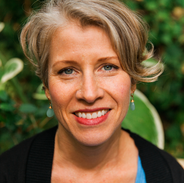 Lael Peterson is a life coach and Certified Yoga Health Coach with over 20 years experience helping people thrive. She specializes in teaching people the habits and mindset they need to accomplish their goals. Her own life experiences with anxiety, addiction, and cancer combined with her professional expertise make her coaching relatable, practical and powerful. Lael is a member at Home Hot Yoga and believes that a regular hatha yoga practice is an essential component in a vibrant life! The Vibrant Life Program is a mini (coed) version of her popular 6 month program for women, Vibrant Body + Wise Mind. A special guest post from nutritional therapy practitioner and fellow yoga student, Amber.
*Please note: none of these comments have been approved by the FDA/CDC/WHO. They are my professional recommendation to help boost the immune system and are not meant as a cure. While the virus may not be deadly to you, it may be deadly to others. Please abide by the quarantine as recommended by the CDC and WHO to help prevent the spread of this disease to our loved ones with conditions that put them at risk. Also, please check with your doctor or myself if you are on any prescription medications as they may interact with the supplements above. Thank you! Wash your hands frequently, don’t touch your face, use products with at least 60% alcohol to disinfect and try to breathe! Take this time to unplug (after you read this of course ☺) and spend some quality time with your immediate family. Enjoy the time away from having to schedule every second of every day and run from one event to another. Just breathe, everything else is optional. I am available if you have any questions. My preferred way to reach out initially is through text message and from there we can set up a time to chat over the phone. Sending all the love and good vibes to you and your family and everyone affected by this virus, Amber Swanson, FNTP 503.789.7108 | [email protected] CascadeNutritionalTherapy.com Hearing Voices: Turn Off the Mind By Tuning in to Bikram Yoga (Special guest blog post by Ellen!)7/15/2018 “Didn’t you just eat too many cucumbers? You might get sick.” That’s what the voice in my head said as I was preparing to attend a recent class. The voice in my head is constantly trying to come up with reasons I should not attend Bikram Yoga class. It tells me I’m too busy, too tired, too stiff, or just plain not good enough to do yoga. Ironically, some of the reasons it gives me for not setting foot in the hot room are exactly the reasons I need to be in there as often as possible. Most days, pushing that voice away is the most important exercise I do, and it’s the one that requires the most strength. Yoga is slowly teaching me to ignore the voice in my head, and it is also teaching me how to listen.
Ideally, from the start of Pranayama Deep Breathing all the way through Kapalbhati in Vajrasana your body should be moving in perfect concert with the instructor’s voice. The instructions describe exactly how to perform each posture, down to the way you should breathe. I find that when I am able to connect perfectly with the teacher’s words my practice is very meditative. It doesn’t happen in every class, but those times are like magic. When I start confusing my right from my left hand in Eagle pose, or wishing I could stand on one leg as easily as some other student, I know that I am not aligned with the instructor. I know that I am not listening. In order to listen I have to tune out the voice in my head. I have to tune out the voice in my head because it interprets events through a lens of emotion. In his book, How Yoga Works, Geshe Michael Roach describes the mind this way: “We lose control of ourselves, even if we have some understanding, and the last thing we can do at that moment of emotion is to recall that it is actually our own minds making us see things the way we do.” (p. 124) And so, the real yoga is not found in Standing Head to Knee Pose or Fixed Firm Pose, or any of the poses. The real yoga is turning off your mind and listening within. Now, I wonder if there are any cucumbers left...? Ellen Cole is a Registered Nurse and has been practicing Bikram yoga at BYSJ since August of 2016. One of her favorite poses is Fixed Firm Pose and she loves doing "doubles" when she gets the chance. Read more of Ellen's yoga story here. Thanks for your contribution, Ellen! 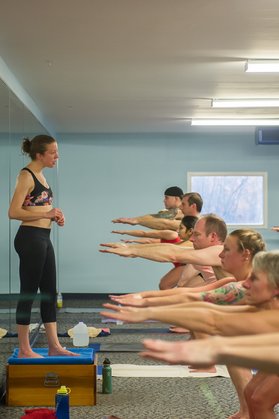 I have been practicing Bikram Yoga since 2006. A back injury I sustained in 1999 limited the activities I could do without pain and a co-worker's encouragement got me into my first class. As a stubborn perfectionist in my 20's, my initial yoga practice was intense, disciplined, and with the singular focus to deepen my postures. After becoming a teacher, practicing consistently over time, dealing with life, and growing as a person, my practice today looks, and feels, WAY different than it did back then! I have always been a rebellious and creative person so it is surprising that I picked Bikram Yoga as my yoga of choice. Here are some tips I use to keep my yoga consistent, nourishing, and healing no matter what is going on. 1) "Just breathe, everything else is optional." - Diane Ducharme-Gardner The most important thing your teachers constantly remind you to do in class is "breathing always normal." If you never did a single yoga posture, but kept your breathing normal, you would still be practicing yoga! If your yoga postures are very pretty on the outside, but you breathe by your mouth, you hold on tightly to your breath, or your breath creates a panicked response in your central nervous system, you are not doing yoga, you are just making body shapes. By breathing normally in and out by your nose you stay present, keep your system calm, and get the intended healing benefits of the postures. Next time you practice, put a little more attention on how you are breathing, especially during the postures you dislike - you may find you dislike them because you are not breathing. 2) Pay attention The dialogue helps to create a moving meditation. When you have been practicing for some time it's easy to tune the teacher out and go at the pace you want to go at. Don't fall into that habit! If you stay with the postures word-by-word, you will deepen the connection between your mind and your body. You will hear different things in the dialogue and you will begin to understand them differently. "Nice and tight contraction" and "completely relax" will each take on new meaning from practice to practice. You will understand your muscles and injuries and sensations in your body. You will start to be able to make better decisions in your practice. Pay attention with your ears, the feelings in your body, and the energy you have on any given day. 3) Adjust your intensity This may be one of the most important lessons I've learned over time. The postures should always be done with the correct alignment and precision of technique. However, the intensity you apply to them should change on a regular basis. If you are feeling great, have gotten lots of sleep, are well hydrated and fed, and have laser beam focus you can practice much differently than if you have been working overnight shifts, have been drinking nothing but coffee, and haven't slept in 3 days. You need to consider yourself in the present moment when you practice because if you don't, you will start to hate your yoga. You should always leave the studio feeling better than you did when you entered it. If you are constantly tired, are in pain, or dread coming back, something needs to change. Give yourself permission to push less, rest more, and perhaps be kinder with yourself during your 90 minutes. Life is crazy and yoga should always make you feel like you can handle it better. If yoga is not helping you, talk to your teachers, they have been there, too, and can help! 4) We're all in this together I recently had a student tell me she was feeling frustrated and discouraged because she felt like everyone else in the room was "getting it" and had great postures and she was the only one that was struggling. Here's a tip from someone that stands on the podium and also stands on a mat - none of us get it and we're all struggling! What I mean by that is you can't tell what is going on with someone internally by looking at them from the outside. I've known people with beautiful looking yoga postures that struggled with chronic pain. I've known people with some wonky looking postures that were so joyous and felt so good in their bodies that you always wanted to be around them. I discover new things about the dialogue and about myself every time I step onto the mat. People share with me every day both their struggles and their successes and how their yoga is so important. Remember that most of us are doing yoga for a reason - because we need it. 5) Simply show up I can't tell you how many times people come up to the front desk terrified of stepping into the room after a long hiatus. They build up the class so intensely in their heads and put huge expectations on themselves for what they need to accomplish. Please go back to the first tip above - just breathe. Most importantly - just show up. The hardest yoga posture you will ever do is Showing-Up-To-Classasana. Bikram Yoga is a beginner's series designed to heal, strengthen, and create resilience in the mind, body, and spirit. Keep this in mind when you step into the room. Take the pressure of performance off yourself an embrace the heat and the healing and the community support of your fellow practitioners. What do you think about these yoga tips? Which one are you most interested in practicing? I can't wait to meet you all and talk everything yoga with you next week! Love, Audrey  Audrey Holst is a Certified Bikram Yoga Instructor, Studio Owner of Bikram Yoga Natick in Massachussetts and professional Stress Reduction Consultant. She will be in residence at BYSJ this May for a whole week- teaching, mentoring our instructors and giving private lessons to you! View Audrey's teaching schedule here. |
AuthorHHY Founder, Yoga Business Coach, yoga-doer and life-lover, Kay Afif! Categories
All
|

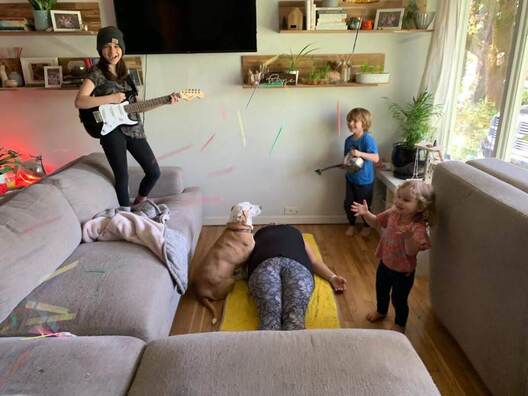
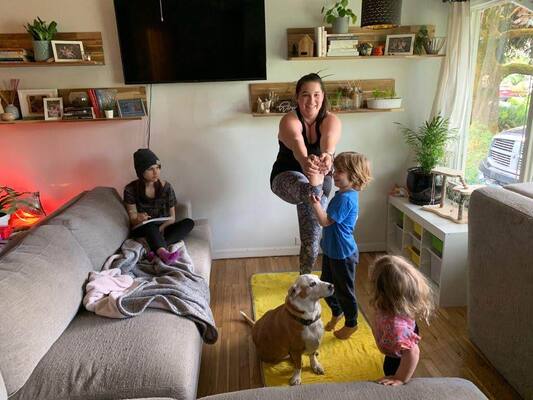
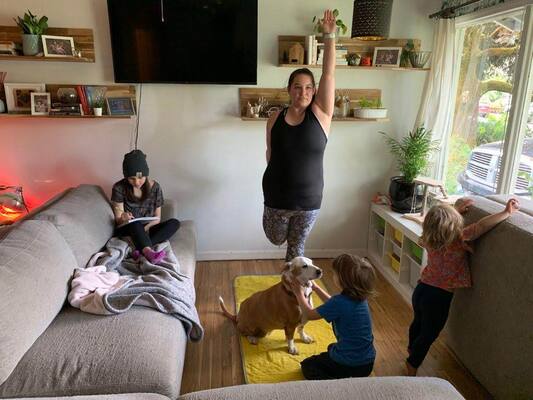
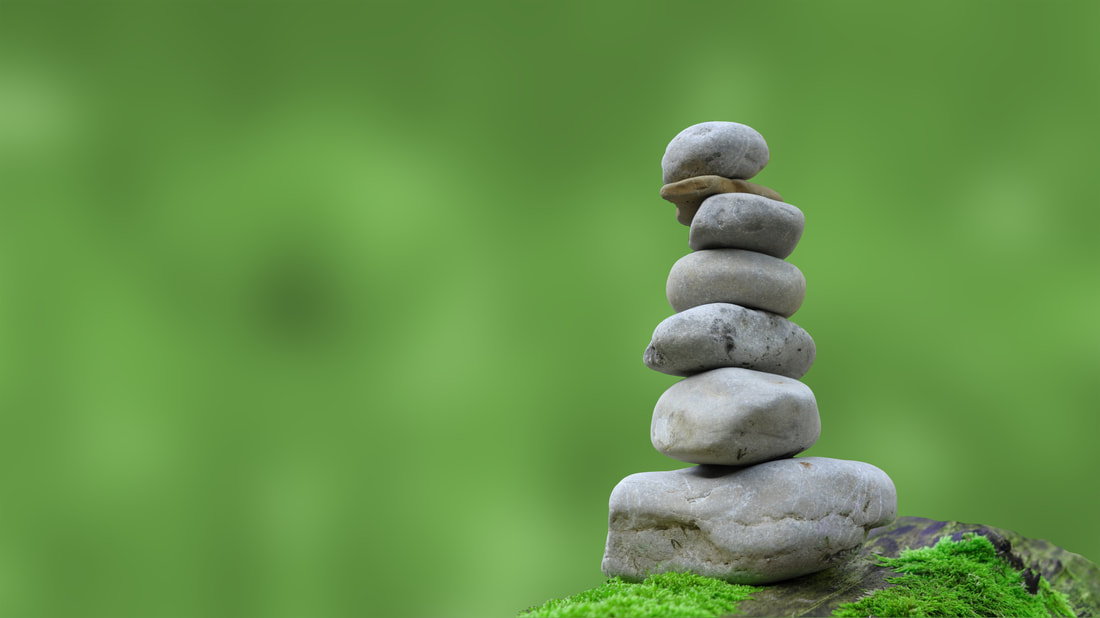


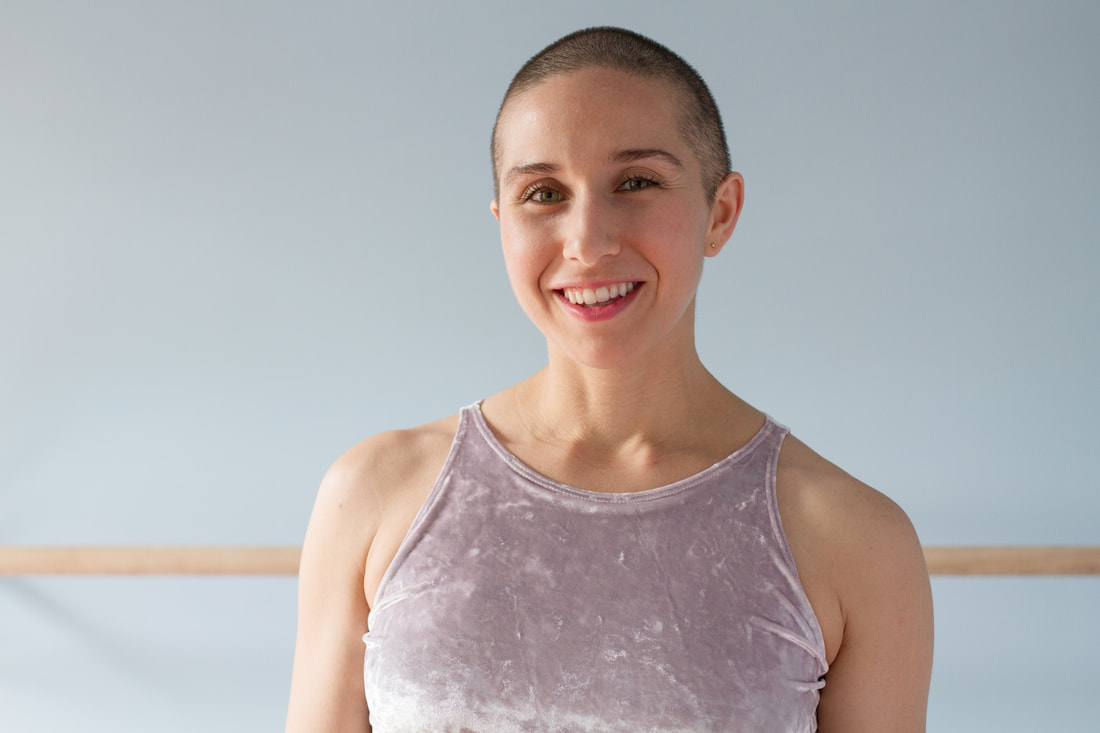
 RSS Feed
RSS Feed
